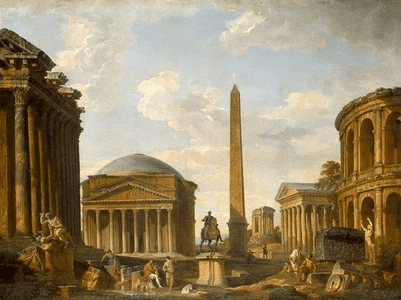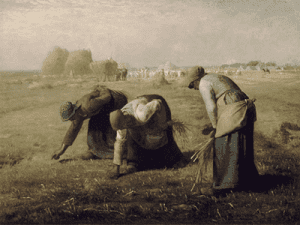Title of Artwork: “Roman Capriccio: The Pantheon and Other Monuments”

Artwork by Giovanni Paolo Panini
Year Created 1735
Summary of Roman Capriccio: The Pantheon and Other Monuments
An oil painting by Giovanni Paolo Panini depicting the Pantheon and other Roman monuments, dated 1735, hangs in the Indianapolis Museum of Art in Indianapolis, Indiana. One can see numerous Roman monuments in the countryside depicted in this painting
All About Roman Capriccio: The Pantheon and Other Monuments
Capriccios, architectural fantasies by Panini are widely regarded as some of the greatest works of art ever created. A wide variety of Roman monuments were joined in this case, with no regard for their location. His depictions of the Obelisk of Thutmose III include the Hadrianic Temple, the Pantheon, the Temple of Vesta, the Maison Carrée, and the Theatre of Marcellus, arranged in a circle around it. Against this overflow of history, he erected an equestrian statue of Marcus Aurelius in the middle of the marketplace.
When it came to geography, Panini was rather careless. But when it came to architecture, he was extraordinarily accurate. He meticulously edited off later modifications, such as the walled-in sections in the arches of the Theater of Marcellus and Bernini’s bell towers on the Pantheon’s pediment, from the original buildings.
The early influences of Panini’s early training as a painter of theatrical scenery can be noticed in this work. Similar to how perspective was achieved in the Italian stage, monuments are arranged. On the “theatre,” there are peasant performers dressed in period garb at the front.
Affluent European adolescents embarked on the Grand Tour in the eighteenth century, and for another half-century afterward, and brought back mementos of their adventures. As a result, Panini and his contemporaries made a lot of money doing sketches and paintings of famous landmarks like those in the Capriccio. For Panini’s paintings, the importance of escape and reflection outweighed the importance of geographical truth, therefore he was free to rearrange the scenery. To better understand the ideal conditions of the monuments and civilizations that built them, a creative restructuring was necessary.
IMA got Roman Capriccio: The Pantheon and Other Monuments as a gift from Lila Allison Lilly in remembrance of her husband, Josiah Kirby, Lilly’s mother. The Jane H. Fortune Gallery is presently showing both. As far as we can tell, it’s accession number is 50.5.
Information Citations
En.wikipedia.org, https://en.wikipedia.org/.
Recommend0 recommendationsPublished in Artworks






Responses